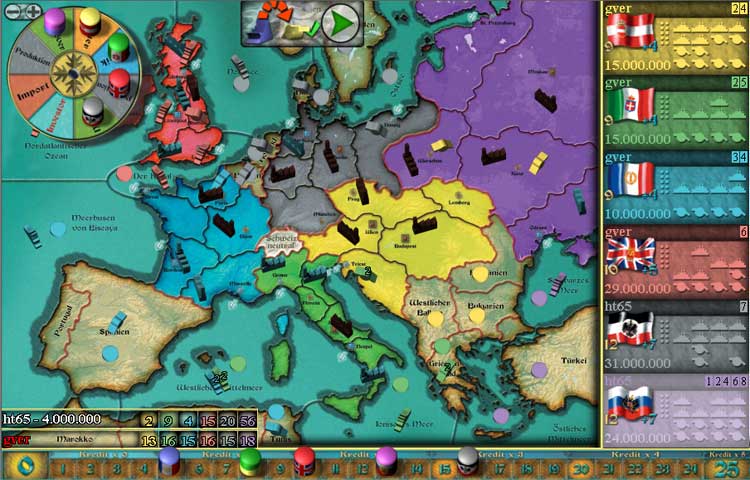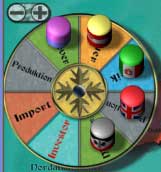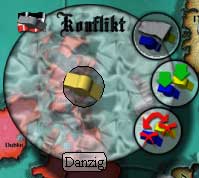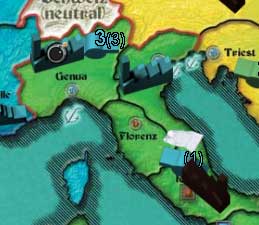Imperial
Imperial (Originalregel)
Starting The Game
You can see the original instructions to Imperial and Imperial 2030 at the site of PD publisher.
The main differences between Imperial and Imperial 2030 are listed here.
With /join 2-6 players can join the game. With /start the game begins. alternative, you can use the Game Tool!
Object of the Game

Each player is an International investor, who influences 6 Super-powers in imperial Europe by loaning finances and therefore manipulating their respective governments. The six states finance themselves was to dare, expand and levy taxes. The goal is to invest wisely with the states which prove to be most successful.
For Imperial veterans, who just need to familiarize themselves with the BSW graphics and components, click on the Concise Guide.
Flow of the game

The nations implement their turns in order. The player, who has granted the highest credit amount to a nation, controls the government of that nation and thus decides the actions on the game board. A player can control several states or even none. In each nation's turn, a space on the Game Dial is chosen and the nation implements the appropriate action. In the first turn any of the spaces on the Game Dial may be chosen. All later turns selected on the Game Dial are advanced in the detection direction. It is not allowed to remain on the same space. The game piece may be moved up to 3 spaces detection at no cost. Each additional space costs the player, who leads the government, 2 million, paid to the bank. The nation's game piece may be advanced to a maximum of 6 spaces.
Aim of the Game
The game ends, as soon as a nation reaches 25 victory points. The winner is the player with the most associated victory points. The exact scoring method is explained at the end. As a rule of thumb it is a factor of interest earned from bonds assocaied with countries with the most victory points. The value of the bonds held by each player is kept secret. Remember that when you control a nations government, it may only be for a short while and that you can engage yourself with several nations at a time.
Starting The Game

At the beginning of the game,players receive money and nation flags depending upon number of fellow players. The exact distribution is explained in the appendix. In the professional variant (Profi), players only receive money and can claim bonds in each country up to the amount of finance they have available. Offers are first made with Austro-Hungary and then rotate round the other 5 until everyone has been given a chance to deal with each nation.
Game Spaces
The 6 actions from the Game Dial are explained in detail. The active state pays all the costs from it's treasury.
- Erecting a Factory
- Production (2x)
- Imports
- Manoeuvre (2x)
- Investors
- Taxation
Erecting a Factory

Nations may build one new factory. Building a factory costs a nation 5 million. Armaments may only be built only in brown cities and shipyards only in light blue cities. A factory may be built only in one of it's own cities, when there are no hostile armies (standing upright upright) in its home province. Only one factory per city. The possible spaces are then shown. To build, click on one of the grey stores where you want to build. Alternatively you can click on the large X to pass.
Should you find out after choosing this action that the country has sufficient funds to complete this action, you can donate money from your own account.
Production

Each armament facility may produce 1 army. Each Shipyard may produce 1 fleet. Production is free. Factories, where these are hostile armies (without white flag), cannot produce. So an occupying foreign force cannot produce in a foreign factory. If your supplies are exhausted, you may elect to switch off production of your factorites by clicking on a green check mark. The production is completed once you click on the large 'PRODUCTION' button as shown in the diagram.
Imports

A nation may import/buy up to 3 military units for 1 million each from the bank. The military units can be set up in all homeland provinces where there are no hostile armies, fleets however only in light ports blue (marked by an anchor). There can be several military units in the same homeland province at the same time. The available locations for import are marked in white. You can decide not to deploy a unit by using the red 'x'. The import is completed once you click on the large 'IMPORT' button as shown in the diagram.
Should you find out after choosing this action that the country has sufficient funds to complete this action, you can donate money from your own account.
Manoeuvre
This turn is conducted in three steps. First the fleets movements, then the army movements, finally placing tax chips.
Fleets

All of a nation's fleets may be moved into an adjacent sea region. Newly built fleets will stand in the port next to the factory. Their first move will therefore always be from the port (marked by an anchor) to the sea region which borders it. Once fleets are at sea, they can no longer return to a port. Use drag and drop to move fleets. Once you have made all your desired fleet movements, click on the large 'FLEET MOVEMENT' button as shown in the diagram.
Armies

A nation's armies can be moved into adjacent areas (except into Switzerland). They may therefore be exposed water via a nation's fleets. To do this there must be one or more adjacent sea areas occupied by that nation's fleet. Each fleet may transport only one army per turn. Transportation by sea is possible only if the army on a land adjacent to an occupied sea space or is reached by railway (see RAIL TRANSPORTATION paragraph). After transportation is complete, the army must end up on a land space. Once you have made all your desired army movements, click on the large 'ARMY MOVEMENT' button as shown in the diagram.
Taxation Marker
A nation may place one of its 10 taxation markers into any unoccupied land or sea area, where there are no military units from other nations. Homeland provinces of other nations cannot be marked by a taxation marker. The taxation marker remains in this region until this region has been taken over by another nation. This can be done via a fight between armies. In this case the existing taxation marker is removed and replaced by the marker of the victor nation.
Combat

If an army moves into a region, in which other nation's armies exist, a fight ensues, if at least one nation wishes. In a fight poories are matched 1:1 and removed from the board.
The aggressor selects an acquired military unit and then clicks the lower button in the combat menu (with the red arrow) to initiate the fight. If he does no want a fight then he would select the green button.
During this scenario, all involved nations are asked via the same window whether they wish to fight or not. Where there is only one army to remove this is done automatically. In the other instance the aggressor MUST select which units to remove. If no-one wishes to fight, then all units remain quietly next to each other in the same region. To reinitiate a fight you must re-enter the state. Fleets and armies can fight against each other only if the fleet is still in port.
Rail Transportation
Each state has a rail network, which operates only within its own state borders. If hostile armies are in a nations homeland province, the rail network is interrupted in this homeland province. Armies may be anywhere within their homeland province via the rail network.
Entering Provinces of the Other Homeland Nations

If you move a nation's army onto the homeland region of another nation, then the government of that army needs to decide whether this is a hostile (normal) or friendly action (white flag). The combat window will open where you can select the upper button (white flag) to show a peaceful intent, otherwise select one of the other two buttons. This button is only active when a hostile nation enters another nation's homeland region. A hostile army stops that region from productiong, importing, building services and taxation. A friendly army does not prevent these actions. However, during the next course of events the status of these poories can all change. And with these changes comes fighting and demise of these poories. If a state has only one factory, which is not occupied by hostile armies, this region may not be hired by hostile armies, and armies of other nations, which enter this region, are set to non-hostile.
Destruction
When three armies of a hostile nation surround a factory, that factory may be demolished by clicking on the bomb symbol with three armies to be destroyed (and removed from the board), provided that there are no armies or fleets of the homeland nation present there. Exception: If a state has only one factory, which is not occupied by hostile armies, then this factory may not be destroyed.
Investors

This action is implemented in three steps. If the nation's marker moves over the 'INVESTOR' space, then only steps 2 and 3 are implemented.
1st: Paying Interest
Each player, who granted bonds with a nation, gets interest from its treasury. If the treasury does not have enough money to pay off all the interest for the bonds provided, the player who leads the government for this nation must make payments from his own personal cash. If this cannot be done then the INVESTOR option cannot be selected.
2nd: Activating the Investor
The player, who is holding the investor card (marked RED), gets paid 2 million from the bank and can now invest in any nation. The INVESTMENT window will open. You can increase the value of an existing bond or create a new bond with a different nation. Click on the appropriate buttons. The value and/or the difference is deposited into the treasury. You can pass if you wish.
3rd: Investing (without owning a flag)
Each player, who does currently not lead a government, and therefore has no nation's flag, so may invest. Investing without a flag happens in the same way in the same way as with the player who is in possession of the investor card, however, without receiving 2 million from the bank.
At the end of the investor action, the ownership of each of the investment flag (control of the government) is assessed. The sum of all bonds a player has with a nation is taken into account. If another player now poses more credit in bonds with that nation (a tie means no change), the control of the government changes and the flag moves to the new owner. When a nation's government changes, if a nation has 0 points of power and a player loses his last government, this player receives to 1 million from the player, from whoever took over the government. If a player is not be distract to pay the 1 million, then he does not pay. The Investor Card now moves on to the next player at the end of the investment phase.
Taxation

This phase will proceed automatically in three steps, if the corresponding segment is chosen.
Taxes/Efficiency bonus

The nations taxes consist of two components:
- 2 million unoccupied factory
- 1 million per placed tax marker
A factory is considered "not occupied" if there is no hostile army in the corresponding homeland province. The maximum tax income is 20 millions (10 millions for 5 professionals plus 10 millions from taxation markers)
On the left hand side of the field, directly above the country's treasure, the taxation amount of the last taxation is shown. If the new taxation level should be higher, the difference will be paid as a premium to the controlling player (by the bank, the country's money is not affected). If it gets lower, however, the player does not have to pay any compensation.
Taking
From the tax levied, the nation must pay 1 million pay to each of its armies and fleets immediately. The remaining amount is paid from the bank into the nation's treasury. If the amount is negative, no payment is made.
Nation Victory Points

A country now gets Nation Victory Points, depending on the tax level (5 points less than tax money, with a minimum of 0 and a maximum of 10). The last NVP gain is shown on the left hand side of the nation overview, directly above that country's treasury. The newly won NVP will be added to said country's score on the scoring bar on the bottom of the screen. When a country reaches 25 (or more) total NVP, the game ends. When the movement onto the "taxation" segment passed the "investor" segment, however, phases 2 and 3 of that segment won't be played anymore.
Scoring
Scoring at the end of the game is calculated as follows:
Depending upon how many Victory Points each nation reaches they score the following weightings:
- 0-4 Points: 0 weighting
- 5-9 Points: factor 1
- 10-14 Points : factor 2
- 15-19 Points : factor 3
- 20-24 Points : factor 4
- 25 Points : factor 5
The players score the sum of all their bonds (interest value * weighting) and then add their cash to this. With a tie, the player who has the highest bond in the nation with most points of power, wins.
Example: Italy reached 17 points. Italy therefore has a weighting of 3. A player has now the 4 million Bond(interest 2 million), as well as the 16 million Bond (interest 6 million) receives it altogether ((2+6)*3)=24 points for Italy.
Game Options
ProfessionalStart
Here no bonds are distributed at the beginning, however the players receive each the following starting capital:
- 2 players: 40 million
- 3 players: 28 million
- 4 players: 22 million
- 5 players: 18 million
- 6 players: 15 million
The starting player may first select a bond for Austria-Hungary. If they purchase a Austrian-Hungarian bond, they pays the value of the bond into the Austrian-Hungarian treasury. Each other player is then given the opportunity to purchase a Austrian-Hungarian bond (going detection) and pay into it's treasury. This happens for each nation, however, the first person given the option rotates to the next player for each subsequent nation.
Appendix
There are some strategy and tips FAQs given in the Appendix as well as game material. If you are familiar with the game, it is not necessary to study the Appendix.
Furthermore, here again the operating instructions Reference.

